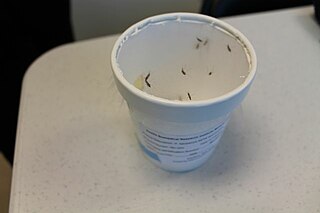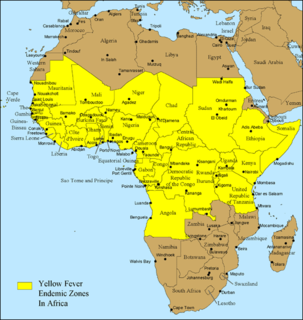Related Research Articles

Malaria is a mosquito-borne infectious disease that affects humans and other animals. Malaria causes symptoms that typically include fever, tiredness, vomiting, and headaches. In severe cases, it can cause jaundice, seizures, coma, or death. Symptoms usually begin ten to fifteen days after being bitten by an infected mosquito. If not properly treated, people may have recurrences of the disease months later. In those who have recently survived an infection, reinfection usually causes milder symptoms. This partial resistance disappears over months to years if the person has no continuing exposure to malaria.

Plasmodium falciparum is a unicellular protozoan parasite of humans, and the deadliest species of Plasmodium that causes malaria in humans. The parasite is transmitted through the bite of a female Anopheles mosquito and causes the disease's most dangerous form, falciparum malaria. It is responsible for around 50% of all malaria cases. P. falciparum is therefore regarded as the deadliest parasite in humans. It is also associated with the development of blood cancer and is classified as Group 2A carcinogen.

Doxycycline is a broad-spectrum tetracycline-class antibiotic used in the treatment of infections caused by bacteria and certain parasites. It is used to treat bacterial pneumonia, acne, chlamydia infections, Lyme disease, cholera, typhus, and syphilis. It is also used to prevent malaria in combination with quinine. Doxycycline may be taken by mouth or by injection into a vein.

Tropical medicine is an interdisciplinary branch of medicine that deals with health issues that occur uniquely, are more widespread, or are more difficult to control in tropical and subtropical regions.

Artesunate (AS) is a medication used to treat malaria. The intravenous form is preferred to quinine for severe malaria. Often it is used as part of combination therapy, such as artesunate plus mefloquine. It is not used for the prevention of malaria. Artesunate can be given by injection into a vein, injection into a muscle, by mouth, and by rectum.

Plasmodium vivax is a protozoal parasite and a human pathogen. This parasite is the most frequent and widely distributed cause of recurring malaria. Although it is less virulent than Plasmodium falciparum, the deadliest of the five human malaria parasites, P. vivax malaria infections can lead to severe disease and death, often due to splenomegaly. P. vivax is carried by the female Anopheles mosquito; the males do not bite.

Plasmodium knowlesi is a parasite that causes malaria in humans and other primates. It is found throughout Southeast Asia, and is the most common cause of human malaria in Malaysia. Like other Plasmodium species, P. knowlesi has a life cycle that requires infection of both a mosquito and a warm-blooded host. While the natural warm-blooded hosts of P. knowlesi are likely various Old World monkeys, humans can be infected by P. knowlesi if they are fed upon by infected mosquitoes. P. knowlesi is a eukaryote in the phylum Apicomplexa, genus Plasmodium, and subgenus Plasmodium. It is most closely related to the human parasite Plasmodium vivax as well as other Plasmodium species that infect non-human primates.
Hemoglobin C is an abnormal hemoglobin in which glutamic acid residue at the 6th position of the β-globin chain is replaced with a lysine residue due to a point mutation in the HBB gene. People with one copy of the gene for hemoglobin C do not experience symptoms, but can pass the abnormal gene on to their children. Those with two copies of the gene are said to have hemoglobin C disease and can experience mild anemia. It is possible for a person to have both the gene for hemoglobin S and the gene for hemoglobin C; this state is called hemoglobin SC disease, and is generally more severe than hemoglobin C disease, but milder than sickle cell anemia.

Sickle cell trait describes a condition in which a person has one abnormal allele of the hemoglobin beta gene, but does not display the severe symptoms of sickle cell disease that occur in a person who has two copies of that allele. Those who are heterozygous for the sickle cell allele produce both normal and abnormal hemoglobin.

A malaria vaccine is a vaccine that is used to prevent malaria. The only approved vaccine, as of 2021, is RTS,S, known by the brand name Mosquirix. It requires four injections.

The history of malaria stretches from its prehistoric origin as a zoonotic disease in the primates of Africa through to the 21st century. A widespread and potentially lethal human infectious disease, at its peak malaria infested every continent, except Antarctica. Its prevention and treatment have been targeted in science and medicine for hundreds of years. Since the discovery of the Plasmodium parasites which cause it, research attention has focused on their biology and as well as that of the mosquitoes which transmit the parasites.

Sickle cell disease (SCD) is a group of blood disorders typically inherited from a person's parents. The most common type is known as sickle cell anaemia. It results in an abnormality in the oxygen-carrying protein haemoglobin found in red blood cells. This leads to a rigid, sickle-like shape under certain circumstances. Problems in sickle cell disease typically begin around 5 to 6 months of age. A number of health problems may develop, such as attacks of pain, anemia, swelling in the hands and feet, bacterial infections and stroke. Long-term pain may develop as people get older. The average life expectancy in the developed world is 40 to 60 years.

Mosquito-borne diseases or mosquito-borne illnesses are diseases caused by bacteria, viruses or parasites transmitted by mosquitoes. Nearly 700 million people get a mosquito-borne illness each year resulting in over one million deaths.
Human genetic resistance to malaria refers to inherited changes in the DNA of humans which increase resistance to malaria and result in increased survival of individuals with those genetic changes. The existence of these genotypes is likely due to evolutionary pressure exerted by parasites of the genus Plasmodium which cause malaria. Since malaria infects red blood cells, these genetic changes are most common alterations to molecules essential for red blood cell function, such as hemoglobin or other cellular proteins or enzymes of red blood cells. These alterations generally protect red blood cells from invasion by Plasmodium parasites or replication of parasites within the red blood cell.
Jonathan J Juliano is an American physician/scientist. He currently works at UNC.

Julie Makani is a Tanzanian medical researcher. From 2014 she is Wellcome Trust Research Fellow and Associate Professor in the Department of Haematology and Blood Transfusion at the Muhimbili University of Health and Allied Sciences (MUHAS). Also a visiting fellow and consultant to the Nuffield Department of Medicine, University of Oxford, she is based in Dar es Salaam, Tanzania. In 2011, she received the Royal Society Pfizer Award for her work with sickle cell disease.
Anthony Clifford Allison was a South African geneticist and medical scientist who made pioneering studies on the genetic resistance to malaria. Clark completed his primary schooling in Kenya, completed his higher education in South Africa, and obtained a BSc in Medical Science from the University of the Witwatersrand in 1947. He earned his PhD from the University of Oxford in 1950. After working at the Radcliffe Infirmary for two years, he worked as post-doctoral student to Linus Pauling in 1954. After teaching medicine for three years at Oxford, he worked at the Medical Research Council in London. In 1978 he simultaneously worked at the International Laboratory for Research on Animal Diseases (ILRAD) as its Director, and at the World Health Organization's (WHO) Immunology Laboratory, both in Nairobi. He later became the Vice President for Research at Syntex Corporation (1981-1994).
Deepak Gaur was an Indian molecular biologist, and a professor at the School of Biotechnology of Jawaharlal Nehru University. Known for his studies on Plasmodium falciparum, Gaur is a recipient of the N-Bios Prize. The Council of Scientific and Industrial Research, the apex agency of the Government of India for scientific research, awarded him the Shanti Swarup Bhatnagar Prize for Science and Technology, one of the highest Indian science awards, for his contributions to medical sciences in 2017.
Peter Gottfried Kremsner is a specialist in tropical medicine and Full Professor at the University of Tübingen, Germany. Since 1992 he has been leading the Centre de Recherches Médicales de Lambaréné (CERMEL), Gabon, now as president. For about three decades Kremsner has played an important role in the worldwide research of tropical infectious diseases.
Mary R. Galinski is a professor of medicine at the Emory Vaccine Center, Hubert Department of Global Health of the Rollins School of Public Health, and the Department of Medicine of the Emory University School of Medicine.
References
- ↑ "Archived copy" (PDF). Archived from the original (PDF) on 2011-07-17. Retrieved 2010-10-08.
{{cite web}}: CS1 maint: archived copy as title (link) - ↑ Utzinger, Jürg; Marti, Hanspeter; Rollinson, David; Khamis, I. Simba; Stothard, J. Russell; Mohammed, Khalfan A.; Knopp, Stefanie (11 May 2010). "Patterns and Risk Factors of Helminthiasis and Anemia in a Rural and a Peri-urban Community in Zanzibar, in the Context of Helminth Control Programs". PLOS Neglected Tropical Diseases. 4 (5): e681. doi:10.1371/journal.pntd.0000681. PMC 2867941 . PMID 20485491 – via PLoS Journals.
- ↑ Mueller, Angela (6 June 2010). "Can St. Louis save scientists?".
- ↑ "Archived copy" (PDF). Archived from the original (PDF) on 2011-07-19. Retrieved 2010-09-21.
{{cite web}}: CS1 maint: archived copy as title (link) - ↑ "Archived copy". Archived from the original on 2010-06-11. Retrieved 2010-09-21.
{{cite web}}: CS1 maint: archived copy as title (link) - ↑ Post-Dispatch, Samantha Liss St Louis. "St. Louis University eliminates medical research program, 21 jobs". stltoday.com.
- ↑ "Diarrhoeal disease". www.who.int.
- ↑ "Microsoft Word - Final 17july2007.doc" (PDF). Retrieved 2019-06-23.
- ↑ Snow RW, Guerra CA, Noor AM, Myint HY, Hay SI (2005). "The global distribution of clinical episodes of Plasmodium falciparum malaria". Nature. 434 (7030): 214–7. Bibcode:2005Natur.434..214S. doi:10.1038/nature03342. PMC 3128492 . PMID 15759000.
- ↑ "Fact sheet about Malaria". www.who.int.